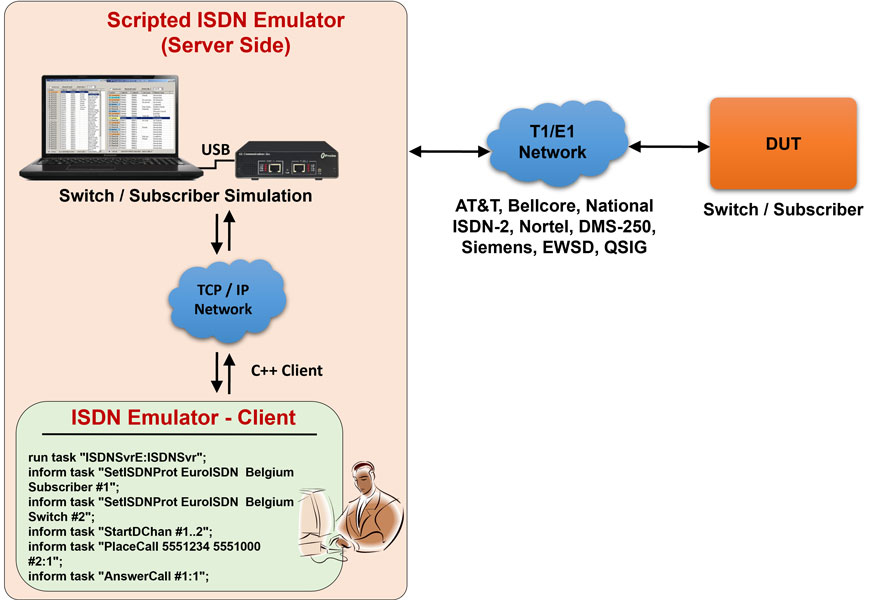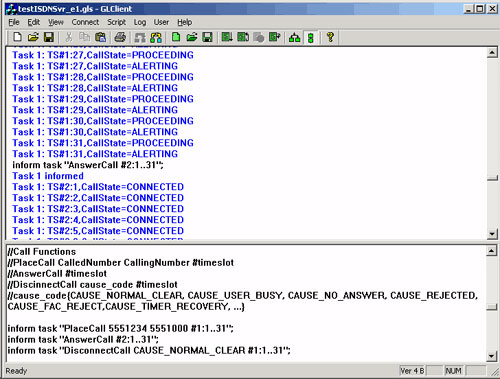ISDN Emulator w/ Command-line Interface
Server/Client Command Reference (C++ client) (Optional Software - xx629)

Overview
GL's ISDN Emulator for T1E1 network is available as GUI based as well as Command-line based applications through which the various ISDN configurations can easily be created, thereby allowing the ISDN Emulator to be fully functional within a few minutes.
The client-server based ISDN Emulator emulates ISDN calls over T1/E1 links. It also allows configuring the ISDN layer parameters, called/calling numbering plan/type, ISDN service type, place or accept call for each timeslot or for the whole trunk, switch and subscriber emulation, simple NFAS setup for T1, and performs various other tasks on remote clients. Additionally, the Windows Client-Server based ISDN Emulator application offers following advantages
- Simultaneous testing of high capacity T1/E1 systems through a single client
- Remotely control ISDN emulation using simple commands by client applications
- Collection of call records from remote locations
Main Features
- Switch and Subscriber emulation
- Nearly all ISDN standards and variants are supported. Variants for T1 analyzers include AT & T #4ESS, AT & T #5ESS, Bellcore #5ESS, National ISDN 2, Nortel, DMS - 250, and Siemens EWSD, while for E1, Variants are Belgium, China, Europe, France, Britain, Germany, and Sweden
- Supported protocol layers - LAPD and Q.931 Layers
- 1 to 4 configurable signaling links
- Performs simple NFAS setup for T1 and various other tasks on remote T1/E1 server
- Call records for complete or incomplete calls
- Place call or accept call for each timeslot or for the whole trunk
Operation
WCS Client applications use "run task" command to invoke ISDN emulator module on server and load ISDN configuration file (*.isd). By default, ISDNConfigT.isd is the initialization file for T1 board and ISDNConfigE.isd is initialization file for E1 board.
Once the ISDN emulator module is initialized, a task number will be assigned and the client can use "inform task #" command to send commands to this task.
ISDN emulator will return all link state and call state to WCS client as task status information. ISDN emulator will also return all error and warning message to WCS client as task error or warning message.

Scripts allow configuring the ISDN layer parameters, called/calling numbering plan/type, type of ISDN service, switch and subscriber emulation, place call or accept call for each timeslot or for the whole trunk. The script below places a call by specifying the called and calling number on all timeslots of card #2. The next task answers the call on all timeslots of card #1. With the third task the successfully established call is disconnected for the specified cause code (Normal_Clear).
The following are the sample scripts for ISDN Emulator (T1 & E1) command via client based window.
Sample scripts
Call placing on single TS (T1)
run task "ISDNSvrT:ISDNSvr";
inform task 3 "SetISDNProt USA AT&T#4ESS Subscriber #1";
inform task 3 "SetISDNProt USA AT&T#4ESS Switch #2";
inform task 3 "StartDChan #1";
inform task 3 "PlaceCall 5551234 5551000 #2:1";
inform task 3 "SetAutoReject Off #1..2";
inform task 3 "SetAutoReject On CAUSE_REJECTED #1..2";
inform task 3 "AnswerCall #1:1";
inform task 3 "DisconnectCall CAUSE_NORMAL_CLEAR #1:1";
inform task 3 "StopDChan #1..2";
inform task 3 "GetStatistics #1..2";
inform task 3 "ResetStatistics #1..2";
end task*;
Bulk Call (T1)
run task "ISDNSvrT:ISDNSvr";
inform task 3 "SetISDNProt USA AT&T#4ESS Switch #1";
inform task 3 "SetISDNProt USA AT&T#4ESS Subscriber #2";
inform task 3 "StartDChan #1..2";
inform task 3 "PlaceCall 5551234 5551000 #2:0..22";
inform task 3 "AnswerCall #1:0..22";
inform task 3 "DisconnectCall CAUSE_NORMAL_CLEAR #1:0..22";
inform task 3 "StopDChan #1..2";
end task*;
NFAS Script
The client-side application also allows users can perform simple NFAS setup for T1. NFAS is a standard option available for ISDN call processing system. NFAS Group-configuration allows number of trunks to be classified into groups, with each group having a unique and identifiable D-Channel. The sample script below demonstrates an ISDN place-answer call with NFAS setup.
The script below groups Trunk 1-Trunk 2 (Group 1), and Trunk 3-Trunk 4 (Group 2) with one trunk in each NFAS group set as 'Primary D-Channel'. Here Trunk 1 is the Primary D-Channel in NFAS group 1 and Trunk 3 is the Primary D-Channel in NFAS group 2. The script places the call on TS 23 of Trunk 2 and answered on TS 23 of Trunk 4. So, the signaling channel on Trunk 2 and 4 is free for Traffic.
Call Placed on Single TS (T1)
run task "ISDNSvrT:ISDNSvr";
inform task 2 "SetISDNProt USA AT&T#4ESS Subscriber #1,2";
inform task 2 "SetISDNProt USA AT&T#4ESS Switch #3,4";
inform task 2 "GetISDNProt #1..4";
inform task 2 "SetIsdnNfas 1 Primary_D 0 #1";
inform task 2 "SetIsdnNfas 1 None 1 #2";
inform task 2 "SetIsdnNfas 2 Primary_D 0 #3";
inform task 2 "SetIsdnNfas 2 None 1 #4";
inform task 2 "GetIsdnNfas #1..4";
inform task 2 "StartDChan #1..4";
inform task 2 "GetStatistics #1..4";
inform task 2 "ResetStatistics #1..4";
inform task 2 "PlaceCall 5551234 5551000 #2:23";
inform task 2 "AnswerCall #4:23";
inform task 2 "SetAutoReject On CAUSE_REJECTED #4";
inform task 2 "DisconnectCall CAUSE_NORMAL_CLEAR #2:23";
inform task 2 "StopDChan #1..4";
end task*;Call Placed on all TS (T1)
run task "ISDNSvrT:ISDNSvr";
inform task 1 "SetISDNProt USA AT&T#4ESS Subscriber #1,2";
inform task 1 "SetISDNProt USA AT&T#4ESS Switch #3,4";
inform task 1 "GetISDNProt #1..4";
inform task 1 "SetIsdnNfas 1 Primary_D 0 #1";
inform task 1 "SetIsdnNfas 1 None 1 #2";
inform task 1 "SetIsdnNfas 2 Primary_D 0 #3";
inform task 1 "SetIsdnNfas 2 None 1 #4";
inform task 1 "GetIsdnNfas #1..4";
inform task 1 "StartDChan #1..4";
inform task 1 "GetStatistics #1..4";
inform task 1 "ResetStatistics #1..4";
inform task 1 "PlaceCall 5551234 5551000 #2:0..23";
inform task 1 "AnswerCall #4:0..23";
inform task 1 "PlaceCall 5551234 5551000 #1:0..22";
inform task 1 "AnswerCall #3:0..22";
inform task 1 "SetAutoReject On CAUSE_REJECTED #4";
inform task 1 "DisconnectCall CAUSE_NORMAL_CLEAR #1,2:0..22";
inform task 1 "StopDChan #1..4";
end task*;
For additional syntax download the sample script for T1 ISDN emulator place and answer call
Resources :
Please Note: The XX in the Item No. refers to the hardware platform, listed at the bottom of the Buyer's Guide, which the software will be running on. Therefore, XX can either be ETA or EEA (Octal/Quad Boards), PTA or PEA (tProbe Units), XUT or XUE (Dual PCIe Express) depending upon the hardware.
| Item No. | Item Description |
| XX629 | ISDN Emulator (T1 or E1) w/ command line interface |
| Related Software | |
| XX105 | ISDN Emulator - GUI based (T1 or E1) |
| XX100 | ISDN Analysis Software (T1 or E1) |
| XX090 | HDLC Capture and Playback Software (T1 or E1) |
| XX130 | Frame-Relay Analysis Software (T1 or E1) |
| Related Hardware | |
| PTE001 | tProbe™ Dual T1 E1 Laptop Analyzer with Basic Analyzer Software |
| XTE001 | Dual T1 E1 Express (PCIe) Boards (requires additional licenses) |
| FTE001 | QuadXpress T1E1 Main Board (Quad Port – requires additional licenses) |
| ETE001 | OctalXpress T1E1 Main Board plus Daughter Board (Octal Port – requires additional licenses) |
 Back to Client/Server Scripted Control Software Page
Back to Client/Server Scripted Control Software Page